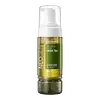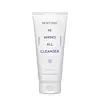What's inside
What's inside
 Key Ingredients
Key Ingredients

No key ingredients
 Benefits
Benefits

 Concerns
Concerns

 Ingredients Side-by-side
Ingredients Side-by-side

Camellia Sinensis Leaf Water
MaskingCamellia Sinensis Leaf
PerfumingSaponaria Officinalis Leaf Extract
AntimicrobialPotassium Cocoyl Glycinate
Glycerin
HumectantMethylglucamine
Lauric Acid
CleansingSapindus Trifoliatus Fruit Extract
Skin ConditioningC12-14 Pareth-12
EmulsifyingMyristic Acid
CleansingPropylene Glycol
HumectantOlive Oil PEG-7 Esters
EmollientCocamidopropyl Betaine
CleansingPEG-60 Hydrogenated Castor Oil
EmulsifyingEthylhexylglycerin
Skin ConditioningCaprylyl Glycol
EmollientTropolone
Skin ConditioningCitric Acid
BufferingTrehalose
HumectantAllantoin
Skin ConditioningAcetyl Glucosamine
Skin ConditioningMoringa Oleifera Seed Extract
Skin ConditioningPlankton Extract
Skin ConditioningVaccinium Myrtillus Fruit/Leaf Extract
AstringentSaccharum Officinarum Extract
MoisturisingAcer Saccharum Extract
Skin ConditioningCitrus Aurantium Dulcis Fruit Extract
MaskingCitrus Medica Limonum Fruit Extract
Skin ConditioningSodium Hyaluronate
HumectantCarica Papaya Fruit Water
Skin ConditioningGypsophila Paniculata Root Extract
Skin ConditioningPanthenol
Skin ConditioningArgania Spinosa Kernel Oil
EmollientNiacinamide
SmoothingAchillea Millefolium Extract
CleansingGentiana Lutea Root Extract
Skin ConditioningPortulaca Oleracea Extract
Skin ConditioningHamamelis Virginiana Extract
AntiseborrhoeicAnthemis Nobilis Flower Extract
MaskingTricholoma Matsutake Extract
Skin ConditioningCordyceps Sinensis Extract
AntioxidantCitrus Paradisi Fruit Extract
Skin ConditioningPisum Sativum Extract
Skin ConditioningGlycine Soja Seed Extract
Skin ConditioningVitis Vinifera Fruit Extract
Skin ConditioningSaururus Chinensis Leaf/Root Extract
AntimicrobialArnica Montana Flower Extract
MaskingArtemisia Absinthium Extract
Skin ConditioningBroussonetia Kazinoki Bark Extract
Skin ConditioningLactobacillus/Aspergillus/Prunus Mume Fruit Ferment Filtrate
Skin ConditioningLactobacillus/Punica Granatum Fruit Ferment Extract
Skin ConditioningLactobacillus/Soybean Ferment Extract
Skin ConditioningLactobacillus/Nelumbo Nucifera Seed Ferment Filtrate
BleachingAristotelia Chilensis Fruit Extract
Skin ConditioningRibes Nigrum Fruit Extract
AstringentChrysanthemum Sibiricum Extract
AntimicrobialPsidium Guajava Fruit Extract
AstringentLaminaria Japonica Extract
Skin ProtectingCaulerpa Lentillifera Extract
Hibiscus Esculentus Fruit Extract
Skin ConditioningMalva Sylvestris Extract
AstringentMalt Extract
Skin ProtectingPassiflora Edulis Fruit Extract
Skin ConditioningAverrhoa Carambola Fruit Extract
Skin ConditioningChenopodium Quinoa Seed Extract
Skin ConditioningDioscorea Japonica Root Extract
Skin ConditioningForsythia Suspensa Fruit Extract
AntioxidantLaminaria Digitata Extract
Skin ProtectingAcorus Calamus Root Extract
PerfumingLithospermum Erythrorhizon Root Extract
Skin ConditioningNelumbo Nucifera Flower Extract
Skin ConditioningCucumis Sativus Fruit Extract
EmollientAngelica Gigas Root Extract
Skin ConditioningPanax Ginseng Root Extract
EmollientCornus Officinalis Fruit Extract
Skin ConditioningSchisandra Chinensis Fruit Extract
Skin ConditioningAsparagus Cochinchinensis Root Extract
Skin ConditioningAmber Extract
Skin ConditioningPinus Densiflora Extract
AntioxidantHydrolyzed Coral
Skin ConditioningTremella Fuciformis Extract
HumectantSarcodon Aspratus Extract
AntioxidantLedebouriella Seseloides Root Extract
Skin ConditioningLepidium Meyenii Root Extract
Skin ConditioningPaeonia Lactiflora Root Extract
Skin ConditioningCitrus Junos Fruit Extract
Skin ConditioningChaenomeles Sinensis Fruit Extract
AntioxidantOryza Sativa Bran Extract
Skin ConditioningCitrus Aurantium Dulcis Flower Extract
Skin ConditioningHippophae Rhamnoides Extract
MaskingGarcinia Mangostana Peel Extract
Skin ConditioningMagnolia Liliflora Flower Extract
Skin ConditioningAngelica Dahurica Root Extract
Skin ConditioningAngelica Archangelica Root Extract
MaskingUncaria Tomentosa Extract
Skin ConditioningLilium Tigrinum Extract
Skin ConditioningLaurus Nobilis Leaf Extract
MaskingMusa Sapientum Fruit Extract
Skin ConditioningCnidium Officinale Root Extract
Skin ConditioningAtractylodes Japonica Rhizome Extract
Skin ConditioningSalicornia Herbacea Extract
Skin ConditioningMangifera Indica Fruit Extract
Skin ConditioningAloe Barbadensis Leaf Extract
EmollientOpuntia Ficus-Indica Extract
Skin ConditioningSwiftlet Nest Extract
Skin ConditioningCocos Nucifera Fruit Extract
EmollientHoney Extract
HumectantLinum Usitatissimum Seed Extract
PerfumingAgaricus Blazei Extract
Skin ConditioningPlumeria Rubra Flower Extract
Skin ConditioningMelissa Officinalis Leaf Extract
Skin ConditioningCymbopogon Citratus Extract
Skin ConditioningCitrus Unshiu Peel Extract
MaskingDisodium EDTA
Carthamus Tinctorius Flower Extract
Skin ConditioningGardenia Florida Fruit Extract
Skin ConditioningParfum
MaskingCamellia Sinensis Leaf Water, Camellia Sinensis Leaf, Saponaria Officinalis Leaf Extract, Potassium Cocoyl Glycinate, Glycerin, Methylglucamine, Lauric Acid, Sapindus Trifoliatus Fruit Extract, C12-14 Pareth-12, Myristic Acid, Propylene Glycol, Olive Oil PEG-7 Esters, Cocamidopropyl Betaine, PEG-60 Hydrogenated Castor Oil, Ethylhexylglycerin, Caprylyl Glycol, Tropolone, Citric Acid, Trehalose, Allantoin, Acetyl Glucosamine, Moringa Oleifera Seed Extract, Plankton Extract, Vaccinium Myrtillus Fruit/Leaf Extract, Saccharum Officinarum Extract, Acer Saccharum Extract, Citrus Aurantium Dulcis Fruit Extract, Citrus Medica Limonum Fruit Extract, Sodium Hyaluronate, Carica Papaya Fruit Water, Gypsophila Paniculata Root Extract, Panthenol, Argania Spinosa Kernel Oil, Niacinamide, Achillea Millefolium Extract, Gentiana Lutea Root Extract, Portulaca Oleracea Extract, Hamamelis Virginiana Extract, Anthemis Nobilis Flower Extract, Tricholoma Matsutake Extract, Cordyceps Sinensis Extract, Citrus Paradisi Fruit Extract, Pisum Sativum Extract, Glycine Soja Seed Extract, Vitis Vinifera Fruit Extract, Saururus Chinensis Leaf/Root Extract, Arnica Montana Flower Extract, Artemisia Absinthium Extract, Broussonetia Kazinoki Bark Extract, Lactobacillus/Aspergillus/Prunus Mume Fruit Ferment Filtrate, Lactobacillus/Punica Granatum Fruit Ferment Extract, Lactobacillus/Soybean Ferment Extract, Lactobacillus/Nelumbo Nucifera Seed Ferment Filtrate, Aristotelia Chilensis Fruit Extract, Ribes Nigrum Fruit Extract, Chrysanthemum Sibiricum Extract, Psidium Guajava Fruit Extract, Laminaria Japonica Extract, Caulerpa Lentillifera Extract, Hibiscus Esculentus Fruit Extract, Malva Sylvestris Extract, Malt Extract, Passiflora Edulis Fruit Extract, Averrhoa Carambola Fruit Extract, Chenopodium Quinoa Seed Extract, Dioscorea Japonica Root Extract, Forsythia Suspensa Fruit Extract, Laminaria Digitata Extract, Acorus Calamus Root Extract, Lithospermum Erythrorhizon Root Extract, Nelumbo Nucifera Flower Extract, Cucumis Sativus Fruit Extract, Angelica Gigas Root Extract, Panax Ginseng Root Extract, Cornus Officinalis Fruit Extract, Schisandra Chinensis Fruit Extract, Asparagus Cochinchinensis Root Extract, Amber Extract, Pinus Densiflora Extract, Hydrolyzed Coral, Tremella Fuciformis Extract, Sarcodon Aspratus Extract, Ledebouriella Seseloides Root Extract, Lepidium Meyenii Root Extract, Paeonia Lactiflora Root Extract, Citrus Junos Fruit Extract, Chaenomeles Sinensis Fruit Extract, Oryza Sativa Bran Extract, Citrus Aurantium Dulcis Flower Extract, Hippophae Rhamnoides Extract, Garcinia Mangostana Peel Extract, Magnolia Liliflora Flower Extract, Angelica Dahurica Root Extract, Angelica Archangelica Root Extract, Uncaria Tomentosa Extract, Lilium Tigrinum Extract, Laurus Nobilis Leaf Extract, Musa Sapientum Fruit Extract, Cnidium Officinale Root Extract, Atractylodes Japonica Rhizome Extract, Salicornia Herbacea Extract, Mangifera Indica Fruit Extract, Aloe Barbadensis Leaf Extract, Opuntia Ficus-Indica Extract, Swiftlet Nest Extract, Cocos Nucifera Fruit Extract, Honey Extract, Linum Usitatissimum Seed Extract, Agaricus Blazei Extract, Plumeria Rubra Flower Extract, Melissa Officinalis Leaf Extract, Cymbopogon Citratus Extract, Citrus Unshiu Peel Extract, Disodium EDTA, Carthamus Tinctorius Flower Extract, Gardenia Florida Fruit Extract, Parfum
Water
Skin ConditioningMyristic Acid
CleansingGlycerin
HumectantPotassium Hydroxide
BufferingPalmitic Acid
EmollientStearic Acid
CleansingLauric Acid
Cleansing1,2-Hexanediol
Skin ConditioningSorbitan Olivate
EmulsifyingGlycol Distearate
EmollientCocamidopropyl Betaine
CleansingGlyceryl Caprylate
EmollientPolyquaternium-7
Sodium Lauroyl Oat Amino Acids
CleansingPolyquaternium-39
Sodium Chloride
MaskingOleic Acid
EmollientArachidonic Acid
EmollientPanthenol
Skin ConditioningAllantoin
Skin ConditioningCapric Acid
CleansingSodium Cocoyl Apple Amino Acids
Skin ConditioningButylene Glycol
HumectantHexylene Glycol
EmulsifyingTetrasodium Glutamate Diacetate
Silk Amino Acids
HumectantCaprylic/Capric Triglyceride
MaskingNelumbo Nucifera Flower Extract
Skin ConditioningCoix Lacryma-Jobi Ma-Yuen Seed Extract
Skin ConditioningMoringa Oleifera Seed Oil
EmollientDisodium EDTA
Sodium Benzoate
MaskingChlorphenesin
AntimicrobialRosmarinus Officinalis Leaf Oil
MaskingWater, Myristic Acid, Glycerin, Potassium Hydroxide, Palmitic Acid, Stearic Acid, Lauric Acid, 1,2-Hexanediol, Sorbitan Olivate, Glycol Distearate, Cocamidopropyl Betaine, Glyceryl Caprylate, Polyquaternium-7, Sodium Lauroyl Oat Amino Acids, Polyquaternium-39, Sodium Chloride, Oleic Acid, Arachidonic Acid, Panthenol, Allantoin, Capric Acid, Sodium Cocoyl Apple Amino Acids, Butylene Glycol, Hexylene Glycol, Tetrasodium Glutamate Diacetate, Silk Amino Acids, Caprylic/Capric Triglyceride, Nelumbo Nucifera Flower Extract, Coix Lacryma-Jobi Ma-Yuen Seed Extract, Moringa Oleifera Seed Oil, Disodium EDTA, Sodium Benzoate, Chlorphenesin, Rosmarinus Officinalis Leaf Oil
 Reviews
Reviews

Ingredients Explained
These ingredients are found in both products.
Ingredients higher up in an ingredient list are typically present in a larger amount.
Allantoin is a soothing ingredient known for its protective and moisturizingg properties. Because of this, it is often added to products with strong active ingredients.
Studies show higher concentrations of this ingredient can promote wound healing.
Though it can be derived from the comfrey plant, allantoin is produced synthetically for cosmetic products to ensure purity.
Learn more about AllantoinCocamidopropyl Betaine is a fatty acid created by mixing similar compounds in coconut oil and dimethylaminopropylamine, a compound with two amino groups.
This ingredient is a surfactant and cleanser. It helps gather the dirt, pollutants, and other impurities in your skin to be washed away. It also helps thicken a product and make the texture more creamy.
Being created from coconut oil means Cocamidopropyl Betaine is hydrating for the skin.
While Cocamidopropyl Betaine was believed to be an allergen, a study from 2012 disproved this. It found two compounds in unpure Cocamidopropyl Betaine to be the irritants: aminoamide and 3-dimethylaminopropylamine. High-grade and pure Cocamidopropyl Betaine did not induce allergic reactions during this study.
Learn more about Cocamidopropyl BetaineDisodium EDTA plays a role in making products more stable by aiding other preservatives.
It is a chelating agent, meaning it neutralizes metal ions that may be found in a product.
Disodium EDTA is a salt of edetic acid and is found to be safe in cosmetic ingredients.
Learn more about Disodium EDTAGlycerin is already naturally found in your skin. It helps moisturize and protect your skin.
A study from 2016 found glycerin to be more effective as a humectant than AHAs and hyaluronic acid.
As a humectant, it helps the skin stay hydrated by pulling moisture to your skin. The low molecular weight of glycerin allows it to pull moisture into the deeper layers of your skin.
Hydrated skin improves your skin barrier; Your skin barrier helps protect against irritants and bacteria.
Glycerin has also been found to have antimicrobial and antiviral properties. Due to these properties, glycerin is often used in wound and burn treatments.
In cosmetics, glycerin is usually derived from plants such as soybean or palm. However, it can also be sourced from animals, such as tallow or animal fat.
This ingredient is organic, colorless, odorless, and non-toxic.
Glycerin is the name for this ingredient in American English. British English uses Glycerol/Glycerine.
Learn more about GlycerinLauric Acid is a fatty acid or lipid. About half of fatty acids in coconut oil is lauric acid.
This ingredient helps hydrate and sooth skin. As a humectant, it helps trap moisture. It also aids in cleaning and enhancing the texture of products.
Lauric acid may not be Malassezia folliculitis, or fungal acne, safe.
Learn more about Lauric AcidMyristic Acid is a saturated fatty acid. It is naturally found in milk fat. Other sources include palm oil, coconut oil, and butter fat.
Myristic Acid is an emulsifer and cleanser. As an emulsifer, it stabilizes a product by preventing ingredients from separating. Myristic Acid helps clean your skin by acting as a surfactant. It tends to gather oil and dirt on your skin to be easily rinsed away.
One study from 2021 found Myristic Acid to have anti-inflammatory properties.
Learn more about Myristic AcidNelumbium Speciosum Flower Extract comes from the Lotus Flower. It is rich in antioxidants.
The antioxidant properties in lotus flower come from compounds such as flavonoids.
In traditional Asian medicine, Lotus flower seeds were used to help treat inflammation.
Learn more about Nelumbo Nucifera Flower ExtractPanthenol is a common ingredient that helps hydrate and soothe the skin. It is found naturally in our skin and hair.
There are two forms of panthenol: D and L.
D-panthenol is also known as dexpanthenol. Most cosmetics use dexpanthenol or a mixture of D and L-panthenol.
Panthenol is famous due to its ability to go deeper into the skin's layers. Using this ingredient has numerous pros (and no cons):
Like hyaluronic acid, panthenol is a humectant. Humectants are able to bind and hold large amounts of water to keep skin hydrated.
This ingredient works well for wound healing. It works by increasing tissue in the wound and helps close open wounds.
Once oxidized, panthenol converts to pantothenic acid. Panthothenic acid is found in all living cells.
This ingredient is also referred to as pro-vitamin B5.
Learn more about Panthenol